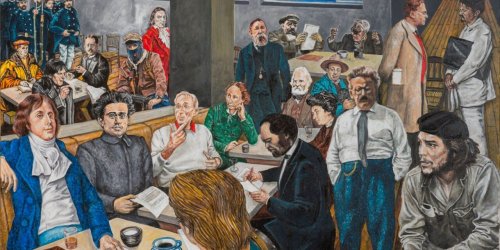The praise and comments, more or less “cultural” and appreciative, are now flowing. All the flora and fauna of Luxembourg’s cultural scene have their say. What is especially remarkable is that virtually no one mentions his political commitment or his revolutionary past, and above all, only his non-political paintings are published!
And yet his main work is political in fact, as a supporter of the Fourth International, Mandel, Bensaïd and Krivine. Moreover, he was very moved when Bensaïd’s book La lente impatience [1] was published. After Bensaïd’s death, he painted a number of related works, including Salle d’attente (The Waiting Room) , an emblematic work that illustrates the links and historical continuities between revolutionaries, Marxist theoreticians, those involved in revolutions, revolutionary processes and workers’ self-organization.
Illustration: La Salle d’attente, Marc-Henri Reckinger, 2014.
Towards the end of the 1960s, Marc Reckinger was a member of a team of Luxembourg teachers who, although initially left-wing, became radicalised under the impact of the Vietnamese revolutionary uprising and then May 1968. Most of them chose the Marxist option and, together with young Luxembourg students from Brussels, eventually set up the Luxembourg section of the Fourth International (in 1971), whose membership grew rapidly. For three or four years Marc was a member of the section’s leadership and an unbridled activist: under his impetus, the section distributed tens of thousands of leaflets in front of or in the metalworking companies (35,000 workers at the time), almost on a weekly basis. At the same time, he provided a graphic framework for LCR meetings, particularly during the elections and for conferences with Mandel and Krivine. He took part in the International’s training schools, as well as a workers’ conference in Antwerp. He was also, for a time, treasurer of the organisation. At the same time, he continued his painting.
After these ultra-activist years, he undoubtedly suffered a sort of burn-out and chose to devote himself to painting, leaving the LCR. He had a Cubist period afterwards, but Marc soon returned to his initial options, namely what might be called "militant realism"! His paintings assert and illustrate solidarity with, for example, the Zapatistas, the Third World, anti-globalisation or ecological movements, criticism of venal sport, opposition to Putin or Trump, the Syrian uprising against Assad, and so on.
While there are few if any references to Surrealism in his paintings, there is a clear affinity with Diego Rivera. Marc was in symbiosis with the joint declaration by Trotsky, Breton and Rivera on the need for "the independence of revolutionary art". Similarly, he agreed with John Berger’s analyses, particularly those concerning art under the Stalinist dictatorship.
In short, he never forgot or denied his past as a revolutionary militant or co-founder of the LCR (the Luxembourg section of the Fourth International). In a way, he illustrated and illuminated it throughout his life!
Hasta la victoria siempre, compañero!
Source: Gauche Anticapitaliste.


